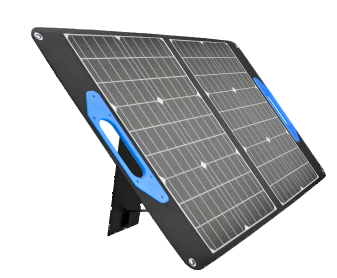Advances in wireless technology, networking and related supporting electronic components have greatly expanded the reach of end-to-end communications, advancing machine-to-machine (M2M) communications from unauthorized proprietary wireless platforms to standards-based air interfaces and applications Interfaces, as well as systems on the network architecture. Economies of scale are driving investment and development to the direction of commercialization of M2M terminals. This article refers to the address: http://
Whaylan Soalr panel.Each module is rated by its DC output power under standard test conditions (STC) and hence the on field output power might vary. Power typically ranges from 100 to 365 Watts (W). The efficiency of a module determines the area of a module given the same rated output – an 8% efficient 230 W module will have twice the area of a 16% efficient 230 W module. Some commercially available solar modules exceed 24% efficiency.
100W Solar Panel,100w 100 Watt Mono Foldable Solar Panel,Foldable Solar Panel,Flexible Solar Panel suzhou whaylan new energy technology co., ltd , https://www.whaylanenergy.com
M2M communication technology has been independently developed on the basis of the implemented wireless platform. Now, M2M solutions for cellular systems and WLAN architectures, as well as networked wireless short-range devices (SRDs), are available, and various wireless technologies that enable M2M communication expansion have been integrated into smartphone platforms.
Smartphone applications typically use a human machine interface (MMI) messaging mechanism. However, we can compare the MMI roles of the various subsystems in the smartphone platform with the important M2M roles in industrial and military applications. This platform provides multi-mode wireless communication between commercial electronic systems such as appliance control, metering equipment, building control and vending. This subsystem platform can also be used as a base commodity to provide M2M communication for a variety of dual-purpose sensing applications. In addition, smartphones have adopted various MEMS sensor technologies to implement enhanced MMI functions, which can also be used to implement direct sensing applications.
LS Research's M2M core hardware platform is such a modified smartphone technology. Our goal is to introduce the latest smartphone technology into the commercial M2M engine, and the resulting hardware platform can achieve M2M connectivity for a variety of applications.
The platform is based on Qualcomm's 8-series Snapdragon smartphone chipset, which provides application processors, cell phone modems, wireless connectivity (WLAN/Bluetooth), GPS receivers and configurable M2M interfaces. M2M's configuration flexibility is provided by the FPGA, which provides a way to convert and control machine data sources, data receivers between application and application interfaces such as UARTs, secure digital I/O interfaces, and general purpose I/O interfaces. , on- and off-sensor inputs, and methods of actuator output.
The system architecture (see Figure 1) is based on the Qualcomm MSM8x60 processor and companion ICs that together implement various forms of wireless connectivity. Unlike packaged smartphone platforms, this unpackaged M2M module does not include the MMI normally required for LCD screens, touch screens/keyboards, cameras, and direct audio interfaces. Those interfaces are split into a 0.5mm high top cover for the user to use the external device. The RF interface uses a miniature U.FL coaxial connector to provide flexibility for antenna selection and application.
Architecture details
The architecture consists of specific functional blocks that meet our flexibility requirements. The application processor is Qualcomm's 1.5GHz asynchronous SMP dual-core Scorpion processor, which is based on the ARM v.7 Cortex instruction set and supports Android and other operating systems. One core is used to process the application and the other is used to implement wireless connectivity. The memory system can support up to 2Gb of capacity through the 333MHz ISM or 266MHz LPDDR2 interface.
The application processor is enhanced with Qualcomm's Adreno 220 2D graphics engine, which supports a 16 megapixel external camera interface and a 24-bit external WSXGA LCD. Advanced graphics features include 3D support, 1080p HD video and HDMI dual screen output.
The hardware platform supports the public cellular phone bands corresponding to the CDMA, UMTS and GSM standards. This coverage is achieved by integrating cellular modem and air interface support processors, as well as supporting radio front-end circuitry. Data service rates of up to 14 Mbps are possible with HSPA+ modems.
The wireless LAN supporting IEEE 802.11b/g/n is implemented by the processor working with the WCN1214 WLAN radio. The WCN2243 Bluetooth radio IC is used to support Bluetooth (BT3.x + HS, Bluetooth 4.0/LE). The processor includes a GPS receiver/engine that implements gpsOne (Qualcomm's A-GPS version), which can be used as a stand-alone GPS receiver or in A-GPS mode.
The MMI connector is used for input devices such as touch screens and keyboards. Standard audio outputs are tapped to support microphones, microphones, and linear audio I/O. The audio interface supports audio functions such as noise/echo cancellation and multimedia features such as Dolby 5.1 surround sound.
The smartphone platform includes on-board sensors to help implement MMI functionality and other applications related to smartphones. Such sensor types include accelerometers and gyroscopes for displaying directions/games, magnetic compasses for navigation, and altimeter based air pressure sensors, as well as ambient light proximity sensors for automatic screen brightness adjustment and intelligent power management.
Low-power FPGAs such as the Microsemi/Actel IGLOO AGL125-AGL400 series manage standard wired interfaces to application processors. This FPGA provides the flexibility to connect data sources/receivers to sensors and provides enhanced power management control.
The Snapdragon processor has been highly optimized for power management in terms of supporting its feature set. However, the FPGA can implement external power management for the chipset during low duty cycle operation by automatically running the timer periodically or by using real-time clock (RTC) and time-of-day scheduling techniques. The RTC function can be further supported by using the second pulse (1PPS) timing reference provided by the GPS engine and the NMEA 0183 messaging mechanism.
In addition, the FPGA interface supports independent non-volatile memory to accumulate and store sensor/machine data when the system is inactive. This allows for the lowest power operation while maintaining sensor/machine connectivity without the need to activate the smartphone processor. 
July 30, 2024